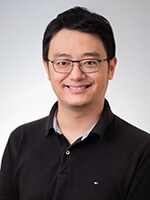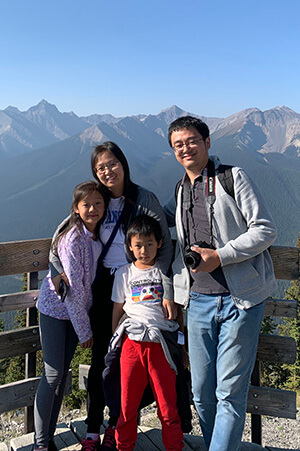Yang Yang, PhD, Spotlight

October 20, 2023
Yang Yang, PhD, is an engineer at heart. As a student, he was earning biomedical engineering degrees while building competition-ready robots. Educated at Xi'an Jiaotong University in China and the University of Virginia, he found his greatest research fascination lay in MRI technique development. Yang joined UCSF in September of 2022 as an Associate Professor in the Department of Radiology and Biomedical Imaging and has quickly made strides in developing a midfield MRI research program at China Basin. He has designed programs that use artificial intelligence (AI) to enhance image quality, spot the effects of COVID-19 and interstitial lung diseases in lung scans, and generate images with which to pre-train other AI models.
Yang was drawn to UCSF’s emerging midfield MRI program. At the University of Virginia, his advisor Michael Salerno, MD, PhD, was a research cardiologist who inspired Yang to concentrate on improving imaging quality for organs that are always moving. This is precisely the kind of technical challenge that Dr. Yang enjoys most, because, as he observes, “There are a lot of engineering problems around motion correction in a snapshot of a heart in motion or a chest during free breathing.”
Midfield MRI is the solution. High-field scanners have been the standard for research and advanced clinical practice, however, they have drawbacks in cost, power requirements, and the time they take to capture a scan. Low-field scanners are faster, cheaper, and more deployable, but struggle to image quickly and produce high-definition images of moving targets. Both high- and low-field imaging rely on a patient’s ability to lie very still and often hold their breath for extended periods. This presents a grave challenge for weak patients who may not be able to exercise that level of control, and an impossibility in areas like fetal imaging or heart imaging.
With midfield MRI, we have the ability to combine the advantages of high- and low-field MRI by using AI image processing to clean up noise and produce analyses that are close to the results of the best high-field scanners while being more accessible and tolerable for patients. Midfield scanners are fast and can have much wider bores than traditional machines. These features can help address claustrophobia and provide access to patients whose weight would otherwise prevent them from entering the machine.
Yang cites David Saloner, PhD, as a very strong supporter of midfield MRI, and a senior faculty member who has provided crucial guidance and connections. Yang noted that, “I call David an encyclopedia of our department. I was new here, so he helped me reach out to physicians for potential collaborations that have become very fruitful. “
Practical-minded by nature, Yang values improving patient health outcomes through his midfield MRI research. Currently, most clinicians use CT scans to image lungs, but Yang’s midfield MRI advances could eliminate radiation exposure to patients, particularly in pediatrics. Internationally, midfield MRI has the potential to make an even greater impact. Access to MRI scanners is still limited in many countries, often due to hardware cost, electricity demand, or lack of continuous helium supply. Yang believes his research has the potential to improve the quality of primary diagnoses, which would result in rapid improvements in patient outcomes across currently underserved areas of the world.
 Yang is always an active problem solver. During the pandemic closures, he struggled to find ways to occupy his two young children. While searching for activities they could do inside their New York City apartment, he discovered his nine-year-old daughter loved chess. So, Yang dove into teaching her and helping her compete in matches. Yang has always had a competitive side himself; while he was at college, his robotics design team won the Asian Pacific championship for three years running. His daughter takes after him and is now ranked nationally as one of the top 15 chess players in her age group. Her younger brother also loves chess and is constantly chasing after his big sister. Together, they follow their father’s lead in valuing precise solutions to complex problems, be it in chess, robots, or advanced imaging.
Yang is always an active problem solver. During the pandemic closures, he struggled to find ways to occupy his two young children. While searching for activities they could do inside their New York City apartment, he discovered his nine-year-old daughter loved chess. So, Yang dove into teaching her and helping her compete in matches. Yang has always had a competitive side himself; while he was at college, his robotics design team won the Asian Pacific championship for three years running. His daughter takes after him and is now ranked nationally as one of the top 15 chess players in her age group. Her younger brother also loves chess and is constantly chasing after his big sister. Together, they follow their father’s lead in valuing precise solutions to complex problems, be it in chess, robots, or advanced imaging.
